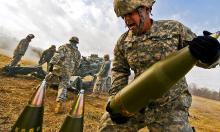Americans try harder and harder to build hypersonic missiles, but nothing comes out yet
Guided hypersonic weapons have given Russia absolute leadership in the field of the development of strategic weapons. No other country in the world, save for, possibly, China, has hypersonic missiles in service. Military analysts do not have any reliable data about China's new weapons. Russia has at least three types of missiles capable of causing irreparable damage to any potential aggressor.
Reference:
- Avangard hypersonic system is capable of developing the speed of up to Mach 28. The system currently uses the Stilett silo-based intercontinental ballistic missile as a carrier. In the future, the new prospective intercontinental ballistic missile Sarmat is to be used for the purpose. For the time being, Russia has four such systems on alert. A missile like that is capable of flying from Saratov to New York in 18 minutes.
- The H-47M2 missile of the Kinzhal (Dagger) complex develops a speed of 12,250 km/h, has a combat range of 3,000 kilometers. Its carrier is the MiG 31K high-altitude fighter-interceptor aircraft. To date, Russia has made several hundreds of Kinzhal missiles.
- The Zircon is the anti-ship missile. It accelerates to Mach 8. Currently, one Russian warship can carry up to 20 Zircon missiles. At the same time, according to open data, at least several hundred units of these missiles have been produced. During naval exercises held in the White Sea this year, the Admiral Gorshkov frigate launched the Zircon missile that successfully struck the target at a distance of over 350 km.
As one can see, all types of Russian hypersonic missiles have already proven their combat effectiveness. At the same time, Russia does not stop here: Russian engineers already work on an air defense system to neutralize hypersonic weapons.
Russia's Supreme Commander-in-Chief — President Putin that is — intrigued the world with his words that he said in 2020:
"I think we will be able to pleasantly surprise our partners with the fact that when they have this weapon, we will most likely have a counter weapon for it."
On August 25, 2021, the US Congressional Research Service released an update to its regular report titled Hypersonic Weapons: Background Information and Questions for Congress.
If one reads the document, one can understand that the United States is about one decade behind Russia in terms of military hypersonic technology.
To bridge the gap with the Russians, the US Department of Defense has asked for about $4 billion for the next fiscal year 2022 for hypersonic programs and about $250 million for anti-hypersonic air defense programs. This year, the Americans have already spent more than $3 billion on the development of hypersonic technology, and $207 million on the creation of air defense systems.
In this regard, we may conclude that in one year our potential enemy has increased the volume of financing by 18-20 percent.
The American media are trying to smooth out the situation, because, as we all know America comes first and wants to be great again. In September of this year, The National Interest published an article by Kris Osborn, a former Pentagon logistics and technology officer, and currently a military columnist. In his article on hypersonic technology, Mr. Osborn wrote that Moscow had impressive samples of hypersonic weapons at its disposal. Nevertheless, Osborn set out a hope that the United States would quickly catch up with Russia, whose progress he called temporary and tactical. Well, it is difficult to expect objectivity from an author like that.
Robert Strider, Deputy Office of the Army's Hypersonic Projects, agrees with Kris Osborn. On August 11, Mr. Strider spoke at a symposium for the development of space and missile defense programs in Huntsville, Alabama. In his speech, Strider lifted the veil from a number of American hypersonic systems. Yet, the high-ranking American specialist forgot to mention that each of them was still in an embryonic stage.
Strider put a special emphasis on the LRHW, the long-range hypersonic weapon. Each launcher will carry two hypersonic missiles. Accordingly, one battery will have the potential of 8 combat units. The complex is to be equipped with a C-HGB (Common Hypersonic Glide Body) warhead. However, the Pentagon does not disclose any information on this topic.
What about anti-hypersonic defense? Is it at all possible to develop means of protection against a technology that you don't know yet? It appears that the Americans do not seem to be embarrassed by such little things of no importance. The main thing is to allocate as much USD as possible, everything else will come along the way.
Where there's the USD, there's a way
As for the area of hypersound defense, the United States considers near space. Back in 2019, it was envisaged to allocate funds for the development and space deployment of a new early warning satellite constellation to combat the "threat of hypersonic and cruise missiles." In June 2020, the Pentagon already gave birth to the DOD Space Strategy, which stipulated for the development of the SBIRS space program — a project from the 1990s — to detect hypersonic launches. The allegedly operational project is to be completed by the end of 2022. In this regard, it is still worth noting that the STSS orbital satellite constellation (SBIRS base) has not been completed yet.
In a nutshell, the Pentagon will probably be able to launch a hypersonic missile in 12 months, but it will not be able to intercept it, because in order to shoot down a hypersonic object, one needs to have another hypersonic weapon.
Japan eyes hypersonic technology too
Japan, a staunch ally of the United States, unveiled a plan to develop a Hypervelocity Gliding Projectile (HVGP) armed with a wide range of warheads by 2025-2026. It is believed that the HVGP will consist of a solid-propellant launch vehicle to deliver the upper stage to the required altitude, where it will be able to gain the required hypersonic speed.
The Japanese media arrogantly declare that such military equipment will outstrip the Russian Zircon by as much as 30% in terms of range and 300% in terms of speed as it will be able to reach Mach 26-27! Tokyo's declared range will amount to 1,300 kilometers. However, no confirmation has materialised to such declarations in objective reality yet. It could probably be another super-duper wishful thinking.
Another country in the Western bloc that can technically reach the heights of the hypersonic technology is France. MBDA and ONERA concerns already work on a project of air-to-surface hypersonic nuclear cruise missiles. The program is codenamed ASN4G. It is worth recalling here that France has its own spaceport and modern missile weapons, as well as nuclear technology. It could be possible that the absence of media hype indicates France's rapid progress towards the ultimate goal.
Many states cherish the dream of building a hypersonic missile. In 2017, CIA's think tank RAND Corp. published an open report on the development of hypersonic missiles. The document featured information on hypersonic projects and scientific research conducted by Israel, Canada, Iran, Pakistan, South Korea, Brazil and even Taiwan and Singapore. However, RAND specialists concluded that engineers from those countries lacked both knowledge and investment.
In conclusion, we would like to note that it will be extremely difficult for other countries to catch up with Russia in the development of military hypersonic technology. Scientists say that an object flying at a speed over Mach 4.5-5 (the hypersound threshold) in dense layers of the atmosphere can be compared to an object that rubs against sandpaper.
Any physical body accelerated to such a speed becomes enveloped in a cloud of plasma. Herbert Efremov, a legendary designer of rocket and space technology, who had devoted more than 30 years of his life to the creation of hypersonic technology, said that a body flying at a hypersonic speed experiences immense turbulent flows and vortices. Hypersonic speed raises temperatures to thousands of degrees, whereas steel can withstand only 1,200 degrees Centigrade, which is nothing compared to those temperatures.
The metal on the surface of the craft literally starts smelting. Russia uses niobium alloy with molybdenum disilicide to cover its hypersonic warheads. This alloy was developed for Soviet space shuttle Spiral. No other country has such man-made materials. In addition, to build a guided hypersonic warhead, one needs to create the liquid fuel ramjet engine. The solid fuel engine, which is used, for example, in Russian Bulava and Topol ICBMs, is not good for the purpose.
To crown it all, one can control and guide Russian hypersonic missiles at all points of their trajectory, despite the plasma cloud around them. They are also capable of dynamic maneuvers to avoid possible interceptor missiles. In other words, it is simply impossible to calculate the direction of their flight in advance.
Based on all the above, neither the United States, nor Japan, nor, possibly, France will be able to develop anything that would outshine the new Russian hypersonic weapons. Not for the upcoming 10-15 years for sure.
Subscribe to Pravda.Ru Telegram channel, Facebook, RSS!




